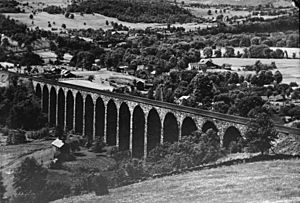Starrucca Viaduct facts for kids
Quick facts for kids Starrucca Viaduct |
|
|---|---|

A 1920 picture of the Starrucca Viaduct.
|
|
| Coordinates | 41°57′47″N 75°35′00″W / 41.963159°N 75.583283°W |
| Carries | Two tracks of the New York, Susquehanna and Western Railway |
| Crosses | Starrucca Creek |
| Locale | Lanesboro, Pennsylvania |
| Maintained by | New York, Susquehanna and Western Railway |
| Characteristics | |
| Design | Stone arch bridge |
| Total length | 1,040 feet (320 m) |
| Width | Two tracks |
| Longest span | Seventeen spans of 50 feet (15 m) |
| Clearance below | 100 feet (30 m) |
| History | |
| Opened | 1848 |
The Starrucca Viaduct is an amazing stone arch bridge located near Lanesboro, Pennsylvania, in the United States. It crosses over Starrucca Creek. Finished in 1848, it cost about $320,000 back then. This was a huge amount of money at the time!
When it was built, the Starrucca Viaduct was the largest stone railway bridge in the world. Many people also thought it was the most expensive railway bridge ever made. Even today, it is still being used by trains. Because it's so important, it's listed on the National Register of Historic Places. It's also recognized as a Historic Civil Engineering Landmark by the American Society of Civil Engineers.
Contents
Building the Starrucca Viaduct
The Starrucca Viaduct was designed by two engineers, Julius W. Adams and James P. Kirkwood. It was built between 1847 and 1848 by the New York and Erie Railroad. The builders used a type of stone called bluestone, which was found nearby.
Why a Bridge Was Needed
The railroad needed a way to cross the wide valley of Starrucca Creek. They first thought about building a large dirt mound, called an embankment. But they soon realized this would be too difficult to do.
The Erie Railroad had money from investors in Britain. Even with funds, most American builders at the time weren't ready for such a big project. So, Julius W. Adams, who was in charge of construction in that area, hired James P. Kirkwood. Kirkwood was a civil engineer who had worked on other railroads.
Who Built It?
It's not fully clear if Kirkwood helped design the bridge or if Adams was the main designer. The main stonemason, Thomas Heavey, was an immigrant from Ireland. He had worked on other projects with Kirkwood before.
About 800 workers helped build the bridge. Each worker earned about $1 per day, which was a good wage back then. They finished the entire bridge in just one year! To build the bridge, they needed a lot of wood for temporary supports, over half a million feet of timber.
Changes Over Time
When it was first built, the bridge had a single track for trains. This track used a "broad gauge," meaning the rails were farther apart than usual. In 1886, this was changed to two standard gauge tracks, which is what most trains use today.
In 1958, the part of the bridge under the tracks was made stronger with a layer of concrete. This helped the bridge last even longer.
The Viaduct Today
The Starrucca Viaduct has been used continuously for more than 150 years! In 2005, the Norfolk Southern Railway leased part of the train line to another company. This company, the Delaware Otsego Corporation, now runs trains on it under the name Central New York Railway.
Today, the only railroad that uses the Starrucca Viaduct is the New York, Susquehanna and Western Railway. This bridge is truly a historic landmark that continues to serve its purpose.
Images for kids




